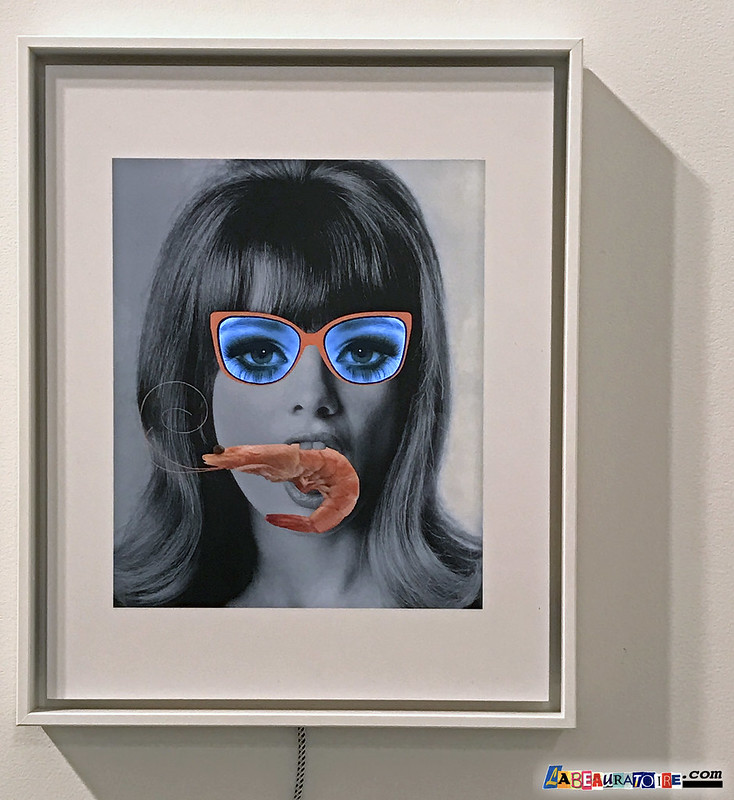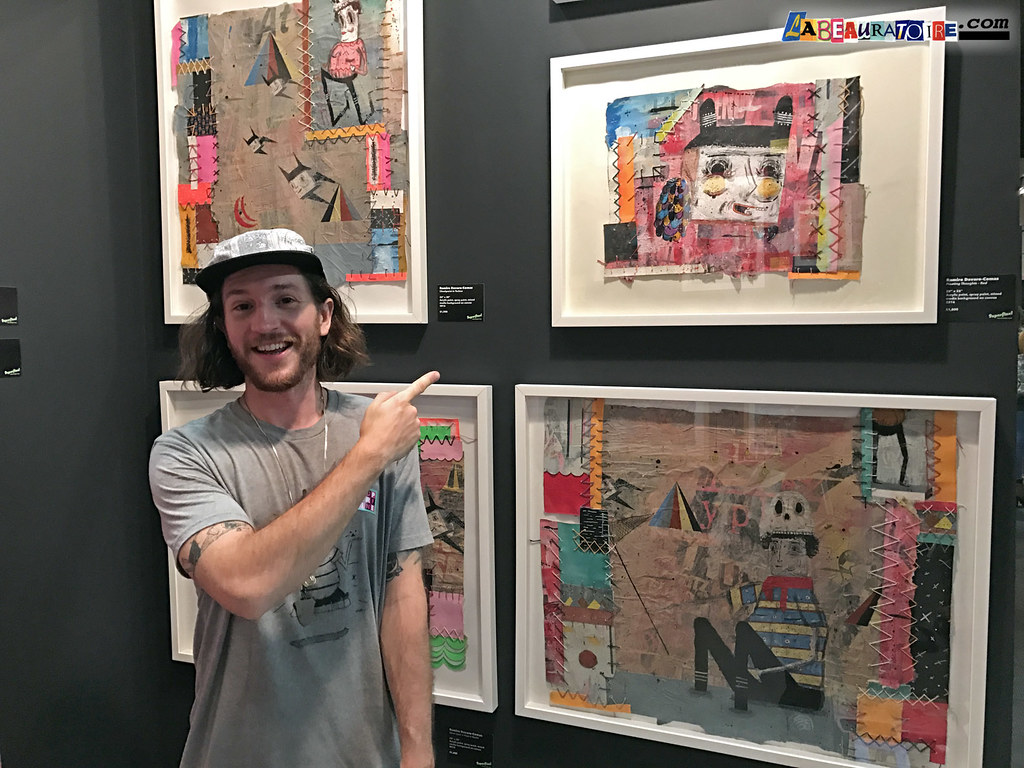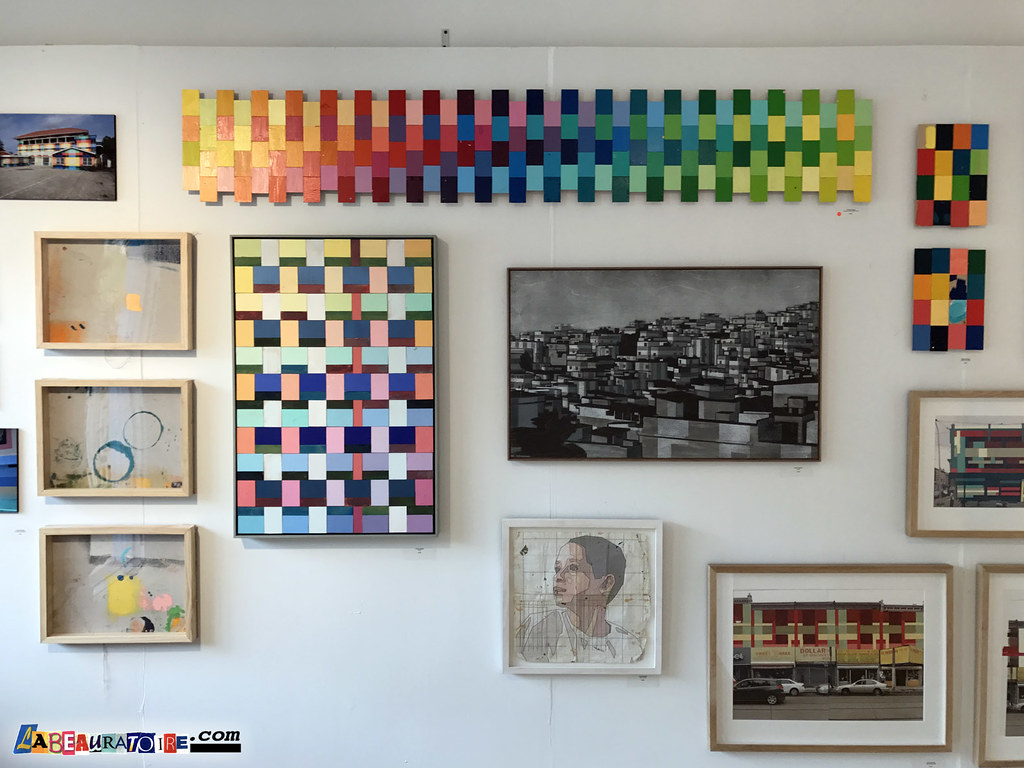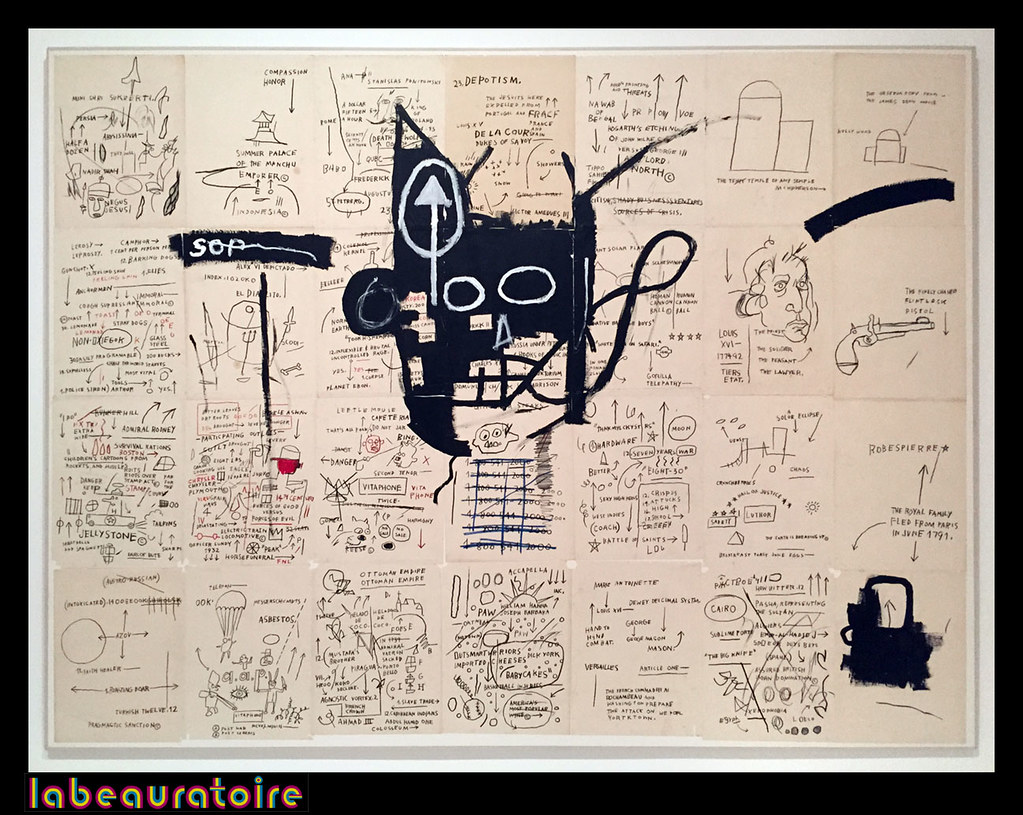A R T W E E K M I A M I 2016

Life imitates art? – A visitor to the SCOPE art fair, beside the piece “Luxury Dinner” by Philippe Shangti, at the Art Angels booth, in Miami Beach, on Sunday, 12/4/16.
TAKING A WHILRWIND GLANCE BACK AT ARTWEEK MIAMI 2016.
(I originally wrote this article back in 2016 and it got stuck in my Drafts Folder when other life events hit my plate. Jut thought I’d go ahead and post what I’d written so it could finally see the light of day.)
MIAMI ~ Seeing everything on view during ArtWeek Miami is a seriously impossible task. With more than 20 official fairs, countless galleries, random gatherings, and pop-up street events, it’s just too much to take in, even if you can get early VIP previews and media access.
In this article, we’ll take a whirlwind tour, stopping to highlight just a fraction of the seemingly infinite events that were vying for viewers on the first weekend in December 2016. Before our more in-depth reviews, (to follow later), we’ll take a quick look at the following events. ArtMiami, Superfine, Wynwood Walls, Peter Tunney Experience, Goldman Global Gallery, Wynwood District Street Art, Aqua Art Fair, INK Miami Art Fair, and Secret Walls Miami. I also covered the The Raw Project at Hartner Elementary School, ArtBasel Miami Beach, and SCOPE Art Fair. But who knows If I’ll ever get to posting those reports.
~ ArtMiami
First up is the Art Miami fair. Located at 3101 NE 1st Ave. in Midtown.

As the longest-running contemporary art fair in the city, this fair showcases modern and contemporary art from 125 international galleries. It strives to provide “an intimate look at some of the most important work at the forefront of the international contemporary art movement.” Housed in a huge tent on a lot between the neighborhoods of Wynwood and Beverly Terrace, it made a good starting point, or base station for exploring most of the other events, especially since it offered a free shuttle service to its sister events CONTEXT Art Fair, just a block away, and AQUA Art Miami on Collins Avenue in Miami Beach.
Their post-fair press release stated they had 78,000 attendees combined for Art Miami and CONTEXT, and hosted 10,500 guests at their VIP Preview.

Art Miami 2016 had all the powerhouse names you’d expect in a Modern and contemporary show, like this Damien Hirst “5-Hydroxyuridine” (above) from Galerie Von Vertes. This Zurich gallery had an impressive booth, with several works by other heavy-hitters like Alexander Calder, Josef Albers, and Robert Rauschenberg.
There were Warhols and Hairings and Banksys and their followers around every corner, but there were definitely some lesser-known gems to be discovered.

Daniel Cherbuin, The Shrimp (groß), 2015, mixed media, edition of 8, video loop: 55 min. 11 sec., 73 x 63 x 3 cm
I was lucky enough to meet the artist Daniel Cherbuin at the booth of Galerie von Braunbehrens. His mixed media “video paintings” were definitely drawing crowds. Their whimsical nature combined with retro iconography, feel like the next step toward the inevitable future of art. Check back later to read my interview with this intriguing artist from Zurich.

Gordon Parks – At Segregated Drinking Fountain, Mobile, Alabama, 1956
2016 – Archival pigment print, Edition of 7 – 34 x 34 inches; 40 3/4 x 39 3/4 inches framed
The New Orleans based Arthur Roger Gallery had a number of unexpected finds. Some incredibly relevant color photographs by groundbreaking photojournalist Gordon Parks, and other wonderful pieces by James Drake, Troy Dugas, and George Dureau.

Detail from “Portrait Group” by Maurizio Anzeri. Embroidery on found photographs.
Another exciting find was the colorful, stitched work by Italian-born London artist Maurizio Anzeri at Haines Gallery out of San Francisco. Using thread and yarn seems to be one of the current fads in contemporary art, but Anzeri definitely puts the medium to an effective use and his embroidery on vintage found photographs was a big standout at this fair.

Another big crowd magnet was the melty work of “3 (three),” a trio of artists from Fukushima, Japan (above) at the booth of the Miami gallery Now Contemporary Art. The anime doll mashup figures and panels pulled viewers in and beckoned them to look closer at the colorful conglomeration of sexy schoolgirl figures. In some cases the figures were bisected, a la Damien Hirst, and allowed viewers to peek inside at the fleshy innards of the pieces.
An overall impressive show, the Art Miami fair is a good median point (both geographically and aesthetically) on the scale between the ultra-high ticket Art Basel Miami Beach, and the more edgy and emerging events like SCOPE and Superfine.
In a recent release, Art Miami claim they’ve signed a multi-year agreement to hold the event at the former Miami Herald site (One Herald Plaza at NE 14th Street at Biscayne Bay) in downtown Miami starting in 2017.
~ SUPERFINE: The Fairest Fair

The Superfine Art Fair had a much more laid back vibe. Located just one block south of Art Miami at 56 NE 29th St. Superfine was also open later (11pm), so offered an inviting spot to wind down after the larger, more buttoned-down fairs. There was more of a festival feeling to this show, with dance music playing and drinks available. Many of the artists themselves accompanied their work and were pleased to interact with attendees.

Argentine artist Ramiro Davaro-Comas (above) was just one of the great artists presented by Organized Chaos Curation and one of the many artists attending the fair and available to discuss their work. His unique, stitched and collaged drawings have a certain naive charm at first, but they get more complicated and refined the longer you investigate their intricate structure. Check back later for my interview with Ramiro.

deStijl is still alive and kicking! One of my favorite art styles, the geometric lines and shapes emblematic of the Dutch deStijl group, pioneered by Mondrian and Van Doesburg, has an infinite potential for new possibilities. New Orleans artist Bean Blackett (above) has tuned in to that wavelength and produced some canvasses that are both fresh and classic at once.

An installation at the booth of Airplane Mode collective presented the controversial work of Master Garrett, with “editions” of the piece available to purchase on USB drive. The rolling video detailed his performance piece titled “PATRON,” where devotees offer the artist “tributes” in exchange for being virtually abused by the burly character portrayed in the piece. Zines from the project were also available for purchase for $3 with intro essay by Emma Sulkowicz.

The vibrant photography of James Miille occupied one of the main central walls at Superfine and it was not surprising to learn that he’s part of the curatorial team and provided most of the imagery for the fair itself. His work walks the tightrope between the real and the surreal. The images often invoke a questioning feeling in the viewer, and that question is “why?” – Why am I seeing what I’m seeing? That visceral interaction is part of its success as a piece of art, and separates it from being just a pretty picture.

The collages of Theodora Richter were another delightful find and another booth where the artist was on the scene to discuss their work. Richter is investigating that eternal relationship between imagery, shape, and structure. Collage is a bit like chess, simple to learn and nearly impossible to master. But with these pieces Richter has proven she’s no novice and makes a strong statement to be added to the lexicon of the medium. Definitely one to keep an eye on. My interview with her will also be coming later.
The Superfine art fair was a blast this year and will hopefully continue to keep its relaxed feel for future fairs. It seems to know what size britches to buy, so it won’t get too big for them.
~ Wynwood Walls.

Kenny Scharf mural near the entrance at Wynwood Walls 2016.
Now in its seventh year, Wynwood Walls has become a kind of defacto geographic center for street art, murals, graffiti and other urban art during ArtWeek in Miami. Each year they invite some of the most popular muralists from around the world to make their mark on the walls of their open-air garden/gallery. While sanctioned “street art” is always somewhat more sterile than work that’s done without permission, the talent and success of their previous roster can’t be denied, and this year’s familiar lineup is no different.

Ron English mural at Wynwood Walls 2016.

PixelPancho mural at Wynwood Walls 2016.
In addition to murals by Kenny Scharf, Ron English and PixelPancho, (all pictured above,) this year’s Wynwood Walls were painted by Aiko, Alexis Diaz, avaf, Case, Crash, Cryptik/DALeast, Daze, eL Seed, Ernest Zacharevic, Fafi, Faile/Bast, Faith47, Futura, Gaia, HowNosm, Hueman, Inti, Kenny Scharf, Lady Pink, Logan Hicks, Maya Hayuk, Miss Van, Neuzz, OS Gemeos, P.H.A.S.E. 2, Peter Tunney, Picho & Avo, Retna, Ron English, Santiago Rubino, Shepard Fairey, Swoon, The London Police, Tristan Eaton, and Vhils.
~ Peter Tunny Experience

Peter Tunney in his Wynwood gallery during ArtWeek 2016.
Nestled right in the center of the Wynwood Walls complex, is the Miami studio and gallery of New York artist Peter Tunny. Stepping into the space offers a nice respite from the Florida heat (yes, even in December), but your eyes certainly don’t get a rest here. There’s an instant onslaught of imagery and Tunny’s artwork is not easily taken in at a glance. It has imagery upon imagery within imagery.

ArtWeek 2016 visitors to Peter Tunney’s gallery in Wynwood, Miami.
Like the proverbial a riddle, wrapped in a mystery, inside an enigma, Tunney’s pieces can be seen on many levels. Most of them have one strong, simple slogan, such as “Change the way you see everything”, or “Crazy Good,” but upon closer inspection, you could spend hours investigating his collage and graphic techniques and still not take in every little detail. His blatant appropriation of contemporary and vintage advertising, not to mention the work of other artists such as Andy Warhol, may put some off, but his skill in combining text and images for impactful results is without question.
~ Originals at Goldman Global Arts Gallery

HUSH & other artists on view at Goldman Global Arts Gallery during ArtWeek Miami 2016.
Goldman Global Arts is the curatorial project of Goldman Properties, which owns the Wynwood Walls property. The Goldman Global Arts Gallery sits in the farthest back section of the Wynwood Walls property, where they hosted the exhibition “Originals,” featuring additional work by many of the artists who who painted this year’s murals. Curated by Jessica Goldman Srebnick and Peter Tunney, visitors got to see new canvasses by artists 1010, Alexis Diaz, Beau Stanton, BIO, Case, Crash, Dasic Fernandez, Daze, Faith XLVII, Fin-Dac, Hueman, Hush, Ken Hiratsuka, Jordan Betten, Logan Hicks, Matthew Ryan Herget, Maya Hayuk, Okuda, Pichi & Avo, PixelPancho, Risk, Ron English, Santiago Rubino, Shepard Fairey, Tatiana Suarez, The London Police, Tristan Eaton, and VHILS.

The gun paintings “Fear Me 1 & 2” by Tristan Eaton (seen in background above) were particularly strong. The monochrome palate is a nice departure from his normally color-rich style. Other standouts were pieces by Hush (2nd above) and PixelPancho, who’s panels in custom-made frames felt a bit like vintage, family heirloom daguerreotypes. And I don’t think anyone stepped up to Beau Stanton‘s eight-foot tall canvas, “Antediluvian Aftermath,” without saying “wow!.” I must have heard it half a dozen times while standing there myself.
Having a “wall-side” gallery with available work by each year’s mural all-stars seems like a no-brainer, and for those of us who normally only get to see Instagram versions of work by the artists we follow, viewing newer work, up close and in person is always a pleasure.
~ Wynwood District Street Art

For about eight blocks in every direction from the Wynwood Walls location, graffiti and street art cover nearly every inch of every wall that isn’t guarded by heavy security. It’s a great place to wander around and discover unsanctioned work by local and international writers and artists alike.

There’s “not even a square to spare” so, in many cases, older pieces are buffed over to make room for new work. Graffiti writers, crews and mural painters from all over the world descend upon the area like locusts and work throughout the week to re-cover every surface they can access. Tags, throwies, masterpieces, and full-blown murals are everywhere you look.

Paint isn’t the only medium used in this yearly attack. Street stickers are a quick and easy way to get your name out there with just a peel and a slap, and they are everywhere! Many are hand drawn on pilfered labels like those from the USPS (Label 228), while others are made by screen-printing or alternative methods of mass production. Stickers are also a good way for artists to make small, quick pieces that are always ready to go up, or get sold to a fan or traded to a fellow artist, and are sometimes collaborated on by several artists or representing a particular crew.

Wheatpasted posters are another popular medium. I saw some nice work by SacSix, Unpolite Art Machine, Bournrich, Barcelona’s Konair, and Denver’s brilliant Frank Kwiatkowski (seen above.)

Other types of installations are all around if you know how to look for them. Minneapolis yarn artist Hot Tea (above) was hitting the fences around Wynwood with his signature three-dimensional wordplay. Cash for Your Warhol, had placed his signs in some strategic locations, and those faux traffic signs (possibly by Olivia Steele?) with slogans like “Control Yourself” (below) were also being ignored by the masses of people who passed by them.

So needless to say, what’s now (apparently) being called the Wynwood Art District is kind of like ten square blocks of nonstop streetart treasure hunt, and there are jewels to be discovered around every corner.
~ Aqua Art Fair
 The Aqua Art Miami fair is one several “hotel” fairs. Similar to the INK, NADA, Fridge, Satellite, and other fairs, Aqua virtually takes over a Miami Beach hotel and utilizes the existing layout to feature its exhibitors. At the Aqua Hotel, 1530 Collins Ave., each room facing the courtyard has been mostly emptied of furniture and replaced with artwork.
The Aqua Art Miami fair is one several “hotel” fairs. Similar to the INK, NADA, Fridge, Satellite, and other fairs, Aqua virtually takes over a Miami Beach hotel and utilizes the existing layout to feature its exhibitors. At the Aqua Hotel, 1530 Collins Ave., each room facing the courtyard has been mostly emptied of furniture and replaced with artwork.
There were too many impressive rooms at Aqua to mention them all here, but there were certainly some that rose above the crowd.

I may be definitely am biased when it comes to the Tampa-based gallery Cass Contemporary. Since opening in early 2014, they have hosted many of my favorite artists and their exhibition space (above) at Aqua was no different. After their opening of a magnificent Shark Toof show, “Red Everything” back in Tampa, they presented some of his innovative work in Miami as well. Some three-dimensional objects have begun to emerge from Shark Toof’s paintings and the effect is fantastic. Accompanying that was new work by St. Petersburg artist BASK, (“Sweet Savage” center) and some remarkable pieces by Dallas artist, Michael Reeder, (right) who’s work was so popular at several fairs, that most of it sold out during the preview events. Check back for more in my full report on Cass at Aqua.

The Kallenbach Gallery, from Amsterdam, paired with Favela Painting, to make a superb presentation. In their space, the Dutch duo Haas&Hahn showcased colorful, geometric details and photographs from their massive mural projects in Rio, Philadelphia, and other cities. The gallery also featured works by other impressive international artists including some exquisite collage/mixed media wood panels by WK Interact.

Working Method Contemporary, is a collective of MFA students at Florida State University, in Tallahassee. Their exhibit presented one of the most unforgettable paintings of the entire weekend. Viewing the piece “Hoarders Paradise” (detail above) by Christina Klein, feels like being caught in a tornado time-warp, one that’s swept through the cubism section of MOMA. Her amazing ability to present an image of such profound structure blended with an equal dose of chaos, leaves the mind properly boggled, and definitely wanting more.
I could have spent the entire weekend just at the Aqua Art fair and still not had enough time to properly appreciate every gallery in attendance. Every time I tried to make my way to the exit, I happened upon another room containing work I HAD to stop and look at. Some of those included: The Derek Gores Gallery from Eau Gallie, FL, Gama Gallery from Istanbul, The Gallery from St. Petersburg, FL, Chicago’s Vertical Gallery, McCaig-Welles & 212 Arts from New York, and J. Fergeson Gallery from Farmville, VA. I hope to write more about my discoveries at these galleries in due time.
~ INK Miami Art Fair

Another “hotel fair,” the INK Miami Art Fair was held at the Dorchester South Beach Hotel at 1850 Collins Ave. Unlike other fairs, this one focuses solely on contemporary and Modern works on paper. Sponsored by the International Fine Print Dealers Association, the exhibitors are all association members, but that doesn’t seem to have restricted the diversity of of the works on offer.

A somewhat hidden gem of the University of South Florida in Tampa is their GraphicStudio, which had a room-full of magnificent work (above) on display at INK.
Established back in 1968, their artists list reads like a who’s-who of printmaking from the last fifty years. Robert Rauschenberg was one of the first artists to work in their facility, but many other greats were to follow, including James Rosenquist, Jim Dine, Ed Ruscha, Judy Chiago, and Chuck Close, just to name just a few.

Robert Rauschenberg “Sheephead” – 1974 – Multicolor relief and intaglio print on fabric with collage of wooden ruler sewn on print.
It’s rare that you get to view such little-known works by Modern masters in person, nevermind having the option to actually purchase one. The Rauschenberg”Sheephead” print (above), priced at $15,900, appeared to have been sold by Saturday morning when I got to see it.

Ed Ruscha – “DO AS TOLD OR SUFFER” – 2001
Many newer artists have also discovered the mastery of GraphicStudio. Artists like Vik Muniz, Alex Katz, Trenton Doyle Hancock, and Christian Marclay (below) have started working with them more recently, and some were on exhibit during this show. If you ever find yourself with spare time in Tampa, do check them out.

Christian Marclay – “Fisssss Bang!” – 2015 – photogravure with aquatint etching
The Rabley Contemporary Gallery, from Marlborough, England, had a lovely display of work, including some very intriguing intaglio and woodcut prints by Naomi Frears. (below)

Naomi Frears – “Just Passing Through” – intaglio and woodcut
I then casually wandered in to the rooms of Stoney Road Press from Dublin. What I saw there, tucked in a back alcove, unassumingly framed, with a standard, white, printed placard, was a piece of artwork that instantly became one of my all-time favorites.

The Irish artist Brian O’Doherty, (before he had temporarily changed his name to Patrick Ireland), invited Marcel Duchamp to his New York apartment in 1966, with intentions to make a portrait of the enigmatic master. The results of this endeavor may be the single most appropriate portrait of an artist I’ve ever seen.
Duchamp once said, “I came to feel an artist might use anything – a dot, a line, the most conventional or unconventional symbol – to say what he wanted to say.”
I can’t imagine a more unconventional way to make a “portrait,” than hooking the subject up to a cardiograph machine, to create a drawing, representing the literal beating heart of the artist himself, (see above). The result is quietly seismic.
Also on exhibit from Stoney Road Press was a series of 28 stunning prints by Garrett Phelan titled “The Hide Suite.” Here’s a detail (below) showing some of the brilliant color combinations.

One of the artists presented by Wildwood Press, out of St. Louis, was Casey Rae. Her large, tryptic titled “Mackinaw City 4 Huron” (below) was simply stunning. The haunting, surreal labyrinth depicted in the three, giclee-printed panels, is easily recognizable as a frozen icescape from a few meters away, but when viewed up close, (which was necessary in the small hotel rooms), the amazing clarity and detail accomplished with the original 4×5 film transparency photograph, really comes to light and virtually sends a chill through the viewer.

I often like smaller concise fairs like this one by INK Miami. They offer a much more narrow selection of work and this allows the viewer to concentrate on one particular medium or movement. The larger (anything-goes) fairs have so many different types of work available, it can be difficult to wrap your mind around it all.
~ Secret Walls Miami 2016

The last shot is just a quick look at the finished wall from early the next morning.
That’s all folks.
























































































